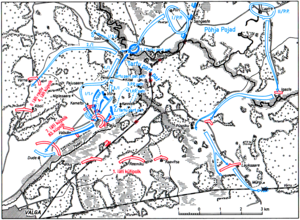Battle of Paju
| date | January 31, 1919 |
|---|---|
| place | Paju manor house, approx. 7.5 km north of Valga |
| output | Estonian-Finnish victory |
| consequences | The Republic of Estonia recaptures southern Estonia |
| Parties to the conflict | |
|---|---|
| Commander | |
| Troop strength | |
| 683 men | approx. 1,200 men |
| losses | |
|
46 dead, 103 injured |
about 300 |
The Battle of Paju ( Estonian Paju lahing ) took place on January 31, 1919 near the southern Estonian Valga . In the strategically important battle, Estonian soldiers and Finnish volunteers faced the Bolshevik Latvian riflemen ( Latvian Latviešu strēlnieki ). After a heavy fight, the Latvian troops cleared the Paju manor. The commander of the Estonian troops, Julius Kuperjanov (1894-1919), fell in battle. The battle was one of the bloodiest of the Estonian War of Independence (1918–1920). It led to the reconquest of all of southern Estonia by Estonian troops.
background
In early January 1919, the Estonian troops began a counter-offensive against the Soviet Russian army. The main aim was to recapture northern Estonia. Narva fell back into Estonian hands on January 17, 1919. At the same time, the Estonian associations advanced further in southern Estonia. On January 14, 1919, Julius Kuperjanov recaptured Tartu from the Bolsheviks using armored trains , Puka and Rõngu on January 25, and Sangaste on January 28 .
The theater of war then shifted towards Valga, which was of particular strategic importance as a railway junction on the route from Tartu to Riga . On the part of the Bolsheviks, among other things, the Latvian riflemen were sent as an elite unit against the Estonian army. In return, the Estonian commander-in-chief, Johan Laidoner , strengthened the Estonian units with Finnish volunteers from Pohjan Poikain rykimentti under the command of Estonian Colonel Hans Kalm , who had already fought in the Finnish Civil War.
battle
The way to recapture Valgas led the Estonian troops through the Paju manor (Estonian Paju mõis ), about 7.5 km north of Valga. On the morning of January 30th, Estonian partisans occupied the estate, but were driven out again by the Latvian riflemen who holed up on the estate. The following day, Kuperjanov decided to launch a major attack with a total of almost 700 soldiers (303 Estonians and 380 Finns), six cannons and 22 machine guns . Estonian armored trains could not be used because the important railway bridge at Tõlliste over the Emajõgi had been destroyed. The Estonian units were faced with the approximately 1,200-strong Latvian riflemen with four cannons, thirteen machine guns, an armored train and several armored vehicles.
The battle began with an attack by 300 Estonians of the Tartu Partisanide Pataljon around 12.40 p.m. over the open field. The Bolsheviks opened fire four hundred meters from the manor and inflicted heavy losses on the Estonian troops. The Estonian commander, Kuperjanov, was seriously wounded and died two days later. The fighting lasted all day, with the Estonian-Finnish assault attacks being repulsed again and again.
The attackers were not able to drive the Latvians into the park of the estate until evening. There there was a bloody close combat between the troops. The fleeing Latvian associations continued to be subjected to heavy fire before Estonians and Finns finally occupied the manor. The Battle of Paju ended in a loss-making Estonian-Finnish victory.
46 soldiers of the Estonian-Finnish Union were killed and 103 injured. The following day, the Estonian troops marched into Valga without a fight, on February 4th in Võru and a day later in Pechory .
The war in southern Estonia was thus decided in favor of the Republic of Estonia. In honor of the slain commander Kuperjanov, the Tartu Partisanide Pataljon was renamed on February 3, 1919 in Kuperjanovi Partisanide Pataljon .
consequences
The battle of Paju led to the final liberation of Valgas from the Bolsheviks. This cut off the railway connection for the Soviet Russian troops. The area of operations of the Bolshevik armored trains was considerably restricted. Estonian troops subsequently expelled the Bolsheviks from all over southern Estonia and continued their offensive to northern Latvia.
memory
Today a granite monument commemorates the battle of Paju. It stands on a three-tiered earth pyramid. The monument was inaugurated by President Lennart Meri in 1994 on the 75th anniversary of the Estonian victory . The place is one of the central memorials of the Estonians to the war of freedom against Soviet Russia. In addition to its actual central importance for the outcome of the war, the battle of Paju is stylized as a national hero myth of the Estonian army and the willingness to make sacrifices.
literature
- Urmas Salo: "Paju lahing: müüt ja tegelikkus" In: Ajalooline Ajakiri 2000 No. 3, pp. 69–96.
- Urmas Salo: "Julius Kuperjanov Paju lahingus" In: Tuna 2004 No. 1, pp. 39-50.
Web links
- Detailed description of the battle and the historical setting (Estonian)
- Full presentation (Estonian)
Individual evidence
- ↑ August Traksmaa: Lühike vabadussõja ajalugu. Tallinn 1992, p. 102.
- ↑ Archived copy ( Memento of the original dated December 6, 2007 in the Internet Archive ) Info: The archive link has been inserted automatically and has not yet been checked. Please check the original and archive link according to the instructions and then remove this notice.
- ↑ Ülo Kaevats: Eesti Entsüklopeedia 7. Tallinn 1994, p. 146.
- ↑ http://www.valgamuuseum.ee/index.php?option=com_content&task=view&id=121&Itemid=85
- ↑ http://vp2001-2006.vpk.ee/en/duties/press_releases.php?gid=43856 ( page no longer available , search in web archives ) Info: The link was automatically marked as defective. Please check the link according to the instructions and then remove this notice.
- ↑ today as jalaväepataljon üksik-Kuperjanovi an infantry - battalion of the Estonian Defense Forces
- ↑ http://www.eesti.ca/?op=article&articleid=16630

